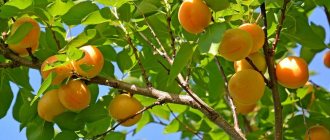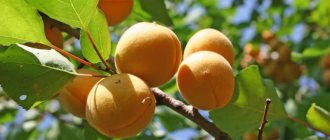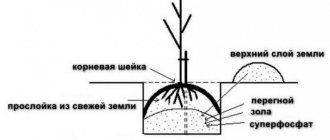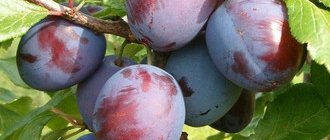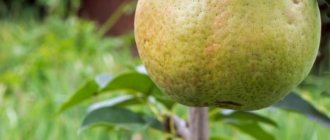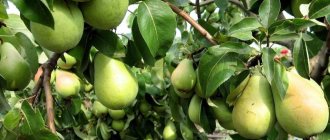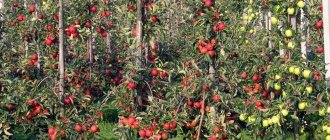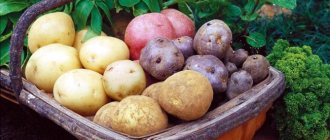Apricot Saratov ruby, as well as its origin, characteristics of yield, its external qualities, ripening time and stability. We will also consider the features of cultivation, planting and care. Apricots are very tasty and healthy; in terms of their qualities, there is little that can be compared with them. Today we will look at the Saratov Rubin apricot variety; it is very stable, productive and hardened.
Apricot Saratov ruby: photo of variety
Apricot Saratov ruby: variety description and characteristics
The Saratov ruby apricot tree reaches a height of up to four or five meters. The crown is spherical and very spreading. After the plant is planted, it will quickly begin to gain strength and grow in height. The bark is brown in color and rough to the touch. The shoots of the apricot tree are medium in length, their shape is straight, and brown in color. The leaves of the Saratov ruby apricot tree are bright green in color, have the shape of a circle, and the end of the leaf is slightly pointed. The front side of the leaf is smooth and glistens in the sun.
Description of the fruits of the apricot tree
The fruits of the Saratov ruby apricot variety are medium in size, one might even say large. One berry can weigh from thirty to forty grams. The shape resembles an oval, the color of the fruit is orange with a pinkish tint. The skin of the fruit is rough and has a small fluff. The pulp inside is orange in color and has a dense structure. There is also a bone inside; it is small in size and can be separated from the pulp very easily.
Forum statistics
207033 Messages in 1634 Topics from 5593 Users. Latest user: Amaya Latest message: “Ripening dates are different...” ( Today at 00:37:47 ) Latest messages on the forum.
Now on the forum
24 Guests, 5 Users
Users in the last 15 minutes: znakomij, Sergey Fer, Alexey V, Anatoly Sivkov, yotmast [Blocked] [Section Moderator] [Forum Moderator]
Maximum online today: 77 . All-time maximum online: 2758 (28 July 2021, 17:22:51)
Users who visited the forum in the last 24 hours
Total: 302
(Visible: 301, Hidden: 1) 1963, znakomij, Sergey Fer, Anatoly Sivkov, yotmast, Alexey V, Ilya 77, Andrey gladilin, Alexander K, Tatyana A., Belgorodets, in Astrakhan, hanter64, Oksana Kopp, Tatyana B, sem_en, Alex65, Vladimir 153, skier, Igor Viktorovich, slavalimon, Alexander Vl., Primorets, OlgaOs, SANYCH, 31rus, mystic69, DorontsovPeter, Andrey Tsvetkov, Buba, Cherkessk, igor222, Andrey76, Elena Z, vlad51, Kenig, Nikolay Rex , Sergey 1965, Vladimir Buturlakin, DSW, psv1960, Dmitry 77, Vasily V., Vyacheslav03, Natalia Nikolaevna, Sergey Tashchiyan, Nikolay S., Igor Sergeevich, alexsandr, kvg, Pioneer, Ekaterina Polyanina, nicson7, Elena Aleshchenko, Alexander-ask -34, Verona, Igor F., Taker, Quiet, Henry, Yuri72, L.A.P., Gaivoronsky Yuri, Sergeevich, Sergei Chistokletov, Svetlana Streletskaya, Galinka, Alexey Deminov, Naumov Igor, Vyacheslav136, Vardan, Gloomy, Katrin , AndSanych, vladimirM, Mikhno Alexander, Ded31, Filippov Oleg, Vladimir ++, Svetla777, Mikhail Alekseevich, Lydia58, Mikhail77, ALEXANDER BRYANSKY, Vladimir-kanevskaya, leonidych, DIL, Amber7394, Marina Protasova, TITOVA LYUBOV, Linx, alexander66, Natalya M, Mikhail Fesenko, ElenkaF, Amaya, Alexander71, Boris 1952, tsv, Maximilian, 25nata35, nadia, GALINA ANOKHINA, Igor_K, Alexander Kolesnikov, Ivan Levin, Pitko, weather forecaster, eSAa, cecet71, atseton, Alexander Smirnov, Vladimir Kostochkin, Vladimir Berdnikov, Gocha, pioneer-2, mers, LeXa_KoT, Sergey 61, Sergey Yuryev, Erem, alexss, Evgeniy52, Skif, lomakin1969, Vladimir Kovba, dayton, Yuri Semyonov, N.A. Sokolov, Pavlentiy, Sa-shura, Volgogradka, Dmitry Anatolyevich, Grandfather Igor, Andrey Lis, Bublichenko Alexander M, Marina Krymskaya, stenlly2010, irahelm, Vyacheslav Vladimirovich, Vladimir Shilov, Aprel, Dmitry Badaev, gheo55, Yura, y_fed, rambo, Yagodka, Valentina Ivanovna, Kryn, oleg9f, DED2, Korotina Svetlana, Delivered Oleg Ivanovich, Eduard., santra, L2k2m7n, Alexander48, Viknik, Andrey 31, m2d, Marshal, Valery Rastorguev, Serg1707, Soshnin Yura, Amateur gardener, Galina, Vasily1111, gardener, marlin64, Salex, sergei, Sergey Ko, Ramiz, victor_, kosmos, potap05, Yuri 36, VitaliySD, Inna161, Vova Kapran, Vladimir Shcherbinin, Valerie, niy1, cfibr, Andrey68, Elvira2017, kulol3, Slavka, thanatos, Serzh1978, Realist, Artur53, max2008-01, LOZA , AlexanderD, Grandfather Young, Natasha, Zayac, ketch, Rita, alx-74, Iv Iv, Alexander150, Igor K, SNovichek, Vasily Viktorovich, VeraNiK, kdm57, Veniaminovich, Boris Sokolyansky, therapist, Capricorn, 77volt, , vikbublik, neposny , Evgen, Victoria Aleksandrovna, Serezha 64, Wintel, Airbone, teri, Sergey Lomonosov, Khramov, serginio, Leonty Yarygin, Irina O., Ser, Nadezhda Grig, zsb, Lyubov S., netolya, Saisan, Agryzkov Alexey, Vadi, Zinaida , Vadim, Alexander Taganrog, Sukhonon Sergey, Snezhinets, Evgen_26, NAU_63, Masha_Sadovod, Gennady163, Krasnovlad1, Alexander Zinoviev, Vasily 53, Roman Fedorovich, Tis, Alexey Sergeyevich, Arnya, Zhek, Nurtas, Kradievska, 64nikolay64, Nick041, Li, Nick041, Li, Nick041, Li, Nick041, Li ZA, Valentine Medvedeva, Sergey43, Andrey S., Nikolay Lipunov, Mst, Vertuoz2, Vladimir VS, NatalyaMed, freesia, Kinna, Mikhail Michurinsk, alekcsan1, VALERY TAMB, Sasha57, MikhAf, Y_Azer, Andrey Beribesov, hunter1955, nut lover, Keys, Ivan Shmelev , Pestle, anton_slash, Nadymchanka, Sergey 31, Volgar, Pavel 64, Tatyana Volzh, Elektronik_t, Alexander 61, spotlight, Alexander Gai, Cheprak, Pirko Alexander, vladimirvrn, Antrikan, asun16, Alexey Viktorovich, YurSanych, bairina, Lekseich, Tatyana Provorova , Sergey Eliseev
Taste and application
Saratov ruby apricots have a sourish-sweet taste. If you evaluate taste on a five-point scale, then the score will be four point three points. The fruits of the Saratov ruby apricot contain substances such as: fruit sugar, dry substances, organic acids, as well as natural pectin and vitamin C. The fruits of this variety can be stored for a long time. If, for example, it is stored in a refrigerator with a temperature of plus five degrees, then it can lie there for up to a month without losing its commercial qualities. Apricot fruits are eaten fresh, and they are also used to make compotes, jams, confitures and marshmallows. If you dry the fruits, you can get a healthy dried fruit called dried apricots.
Apricot Saratov ruby: planting varieties
In places with a cool climate, it is necessary to plant the Saratov ruby apricot in the spring, as soon as all the snow has grown and the earth has warmed up. It is necessary to root the seedling before the buds begin to open on it. If apricots are planted in the south, then preference is given to the autumn period, when all the foliage has fallen. In warm countries, the apricot plant will have time to take root before frost sets in.
Choosing a place to plant apricots
In order for the apricot tree to grow well and bring you a good harvest, it needs to be planted in an area where there are no winds and strong drafts, so that it receives a lot of sunlight and there is no shadow. The soil on which you will plant the plant should be light and loamy. The soil should be neutral or closer to alkaline, but not acidic. If the soil is acidified, then liming is necessary.
Apricot Saratov ruby is strictly prohibited in lowlands where groundwater usually accumulates.
How to select and prepare apricot seedling Saratov ruby
To root the Saratov Ruby apricot variety, you need to choose annual seedlings. When choosing seedlings, make sure that their roots are developed and healthy and that there is no rot. The trunk of the seedling must be free of cracks and other defects. The buds must not have blossomed on the seedling. Before planting an apricot seedling Saratov ruby, you need to shorten its roots and put them in a mash made of clay for a couple of hours, you also need to add mullein there. After this soaking, the roots will become stronger.
Apricot planting
It is necessary to dig a hole in advance. It is recommended to make the hole size seventy by seventy by eighty centimeters. Place fine gravel at the bottom of the hole, then lay a nutrient layer, which should consist of soil and fertilizer. Before planting, the hole must stand. After laying the fertilizer, it should be left for two weeks. Then we take the Saratov Ruby apricot seedling and place it in the middle of the hole and cover it with earth. Next, water the seedling and, if necessary, tie it up.
Diseases and pests, main types and solutions to problems
Saratov ruby is quite resistant to major diseases, but periodic treatment for preventive purposes must be carried out. In addition, the need to use chemicals may be indicated by excessive shedding of fruits against the background of a sufficient amount of water: shedding may be a consequence of infection with gray fruit rot that has not yet fully manifested itself.
One of the clear advantages of the Saratov ruby variety is resistance to fungal diseases. Moniliosis, fruit rot and clasterosporiasis attack it very rarely, which allows the number of sprayings with pesticides to be minimized.
Among the main pests of apricots, the following stand out:
- Plum codling moth: lives mainly in the southern half of the European part of the country. One caterpillar destroys several fruits.
- Fruit moth: develops in the same way as apple moth, but the young caterpillars live openly. During pupation, the cocoons are not located condensed, like those of the apple moth, but randomly, one by one.
- The pollinated plum aphid, in addition to plums, affects apricot, peach, and cherry plum. Aphids are located at the bottom of the leaves, usually in several layers, and damaged leaves do not curl.
The main diseases affecting apricot:
- Stone fruit coccomycosis affects mainly cherries, especially in the western regions of the country, but also plums, cherry plums, apricots and other stone fruits. In June, small purple round spots appear on the leaves. As they increase in size, they merge and take on an irregular shape. Affected leaves fall off and the fruits dry out.
- Clusterosporia blight, or leaf hole, occurs on all stone fruits, but especially affects apricots and peaches. All above-ground parts of trees are affected. On the leaves, the disease manifests itself in the form of rounded light brown spots with a reddish border, at first very small, then increasing in size. The leaves appear to be shot through. When severely damaged, they fall off prematurely. Reddish spots with darker edges form on the shoots. Gum comes out of the cracks. With severe damage, the shoots die. The affected buds die and the flowers fall off.
- With moniliosis, the bark becomes overgrown with a light gray coating, the leaves and branches darken and dry out, the yield on the tree sharply decreases: only some fruits ripen, but most of them crack, rot and dry out while still green.
In the short time since the Saratov ruby won its place in gardens, an algorithm for its preventive spraying has already been worked out. When determining the specific timing of tree treatment, it is necessary to take into account the climate of the region and the current weather. In addition, it is necessary to pay attention to the condition of a particular tree. The first mandatory treatment is carried out in early spring, the last - in the fall, immediately after the end of leaf fall.
During spring treatment, before buds begin to bloom, the most popular are copper sulfate or Bordeaux mixture, which are very effective against diseases such as moniliosis, spotting, coccomycosis and clasteriosporiosis. At the same time, the trunk and crown are sprayed with a urea solution. In parallel with preventive treatment in early spring, it is useful to spray the apricot with one of the drugs that enhance immunity (for example, Zircon).
Bordeaux mixture remains one of the most popular and relatively harmless garden chemicals to this day.
Before flowering, preventive spraying is carried out against overwintered parasites and leaf-eating insects using Kinmiks and colloidal sulfur preparations. The following treatment is carried out during flowering or immediately after it: combined mixtures or the drug Ridomil are recommended.
During fruit growth and ripening, apricots are treated with Horus and sulfur preparations against powdery mildew and coccommycosis. But no treatments are allowed later than 2-3 weeks before harvest! After the leaves fall, the trees are sprayed with urea.
Apricot Saratov ruby: care rules
The apricot variety Saratov ruby is an unpretentious plant, but care should be taken, as this increases the yield. Feed the plant with fertilizer every growing season. Feeding can be carried out several times during the season. In the spring you need to add urea or mullein, this promotes the growth of green mass. To ensure that the fruits ripen quickly, phosphorus and potassium are added under the plant in the summer and late spring. The Saratov Ruby apricot tree should be watered with warm water as needed. This plant needs more moisture when it blooms; it needs water during this period in order for as many fruit ovaries to form as possible. The plant may also have pathologies, such as brown spot. This disease is a fungal disease. If such a disease appears, then small yellow spots will appear on the leaves, and these spots will gradually spread over the entire leaf and turn brown in color. To combat such a fungus, it is necessary to spray the plant with the preparation “Copper sulfate.” Apricot plants can also be taken over by aphids. It usually affects young foliage and shoots. This pest is very dangerous, as it subsequently reduces the harvest. You can overcome aphids by spraying with Fitoverm and Karbofos.
Features of cultivation and subtleties of care
The main measures for caring for apricots of the Saratov ruby variety do not differ from those for most other varieties of apricots. This includes moderate watering, timely fertilizing, destruction of weeds, spraying against diseases and harmful insects, whitewashing trunks and skeletal branches for the winter.
Watering
As for watering, it is needed mainly during fruit filling. True, young trees that have not yet grown a root system need to be watered frequently in the first 2–3 years, but not to the point of waterlogging.
Mature apricots, if the summer is not extremely dry, are quite capable of finding water for themselves for most of the growing season.
In arid regions, watering is necessary; it is carried out approximately once a month, with a sufficient amount of water, but so that it does not stagnate around the trunk. Of course, ideally this should be warm, settled water, but in extreme cases, regular watering from a hose will do, only if the water does not come from an artesian well: this is usually too cold.
Feeding
Apricot needs systematic feeding. In the spring, the best option is liquid fertilizing with solutions of mullein and bird droppings, which, to a first approximation, can be replaced with urea and potassium nitrate. In June, foliar feeding is good - spraying tree foliage with solutions of complex fertilizers. From mid-summer, nitrogen-containing solutions should be replaced with phosphorus-potassium solutions; they promote the formation of fruit ovaries. After harvesting, the best option is to scatter half a bucket of wood ash around the tree and bury it shallowly with a shovel or hoe. Once every few years in the spring or late autumn, small holes are dug next to the tree and 1-2 buckets of manure or compost are placed in them.
Trimming
Apricots have a tendency to grow their crowns excessively, leading to excessive thickening. Saratov ruby is no exception; it requires regular formative and sanitary-rejuvenating pruning. In the process of formation, its crown should be given a rounded shape that is natural for the variety. The very first pruning in the life of an apricot was discussed in the section devoted to its planting. Over the next few years, up to 6–7 skeletal branches are formed on the apricot tree, on which second-order forks are formed.
Typically, trees such as apple or pear trees are pruned in the spring and fall. Apricots also have to be pruned in summer. In the spring, thickened areas of the crown should be thinned out, weak branches that have not overwintered should be cut out. Fruit branches older than three years are also cut out: their harvest will already be weak. Saratov ruby almost does not shed excess fruits, as a result of which the branches may not withstand the weight of the harvest and break, so even after pruning, you will need to carefully monitor the number of fruits set and, if there are too many of them, support the skeletal branches. Spring pruning should be carried out a month before the start of the growing season, when frosts will no longer return, but sap flow has not yet begun. Thanks to this pruning, the crown becomes easily accessible to sunlight and reasonable ventilation.
In the summer, the thinning operation can be repeated, but only if there is a sufficient amount of moisture (from rain or watering), shortening by a third and young shoots that are growing too powerfully. If necessary, you can remove some of the excess fruit or completely excess branches. Summer pruning benefits apricots: flower buds develop better on new shoots. Pruning in summer is carried out in the first ten days of June. After it, the fruits grow larger and become sweeter.
Recent Entries
5 working ways to use tar in the garden 7 indoor plants that help you get married even in adulthood Indoor plants that can bloom in trouble
In the fall, it is necessary to remove weak and diseased shoots, covering large cuts with garden varnish. During autumn pruning, experienced gardeners shorten most young branches by 1/3 of the length, leaving only 6–7 buds on them. Apricot pruning should be carried out regularly; if it is not done, the trees are at risk of bearing fruit periodically. Removing excess branches rejuvenates the apricot, increases yield and resistance to disease. Autumn pruning is carried out in mid-October.
Video: formative pruning of an apricot tree
Preparing for winter
Preparing a tree for wintering consists of cleaning all plant debris around it, digging up the tree trunk, and spraying with insecticidal preparations. As an adult, the Saratov ruby overwinters without any shelter, but the trunks of young trees for the winter should be covered with spruce branches and wrapped with non-woven material on top. Disputes between gardeners are caused by hilling the trunks of young trees with soil. On the one hand, this is a good warming procedure. But on the other hand, winter thaws in this case will hit the root collar even more painfully, and its damping off is much worse for apricots than frosts.
To protect against hares and mice, the lower branches and trunk of young apricots must be covered with durable materials, and here, too, the prickly coniferous spruce branches have no competition. With the arrival of spring, before the sap begins to flow, apricot trunks are whitened with lime, but if possible, this procedure should be carried out even earlier: the most dangerous sun illuminates the trees already in March.
Apricot Saratov ruby: reviews from gardeners
- Natalya Petrovna, Samara region: “Initially, when I first bought Saratov ruby apricot seedlings, the seller assured that this variety can grow without pollinators. However, then I learned from friends who grow this variety that it is still better to plant Saratov ruby as a pollinator for the apricot so that the tree develops better and faster. I was a little upset, but I did it. Now my garden plot boasts several fruit-bearing and actively developing apricot trees.”
- Svetlana Alekseevna, Volgograd region: “The Saratov ruby apricot has been growing in my garden not long ago. But a couple of times I have already managed to enjoy a rich and tasty harvest of ripe fruits. I used the Saratov Rubin apricot variety to make jam and preserves, and they are also ideal for fresh consumption. The winter hardiness of the Saratov ruby apricot is very high, and this greatly facilitates the cultivation of the tree.”
Reviews
Let's find out what gardeners say about this variety of apricots.
Alexander, Voronezh:
There are several fruit trees growing on the property near my house: since there is not much space, I choose only the most successful varieties. I liked the Saratov ruby right away, so the tree has been growing happily for the seventh year now.
The yield is good: it bears fruit without problems, even if the winter was cold. The fruits are tasty, but not too juicy - this is not for everyone. This is just right for me for preparations, but some people might like it a bit juicier.
Larisa, Samara:
I took up gardening not so long ago - just a few years ago after I retired. I purchased seedlings from a nursery - they advised me to take Saratov ruby apricot.
I really liked the variety - it took root perfectly, grew quickly, and in the fourth year it bore fruit. Apricots ripen well, turn out quite large and tasty. The harvest hangs on the branches for a long time, does not crumble much, and does not rot. I like this variety and recommend it to all my neighbors.
